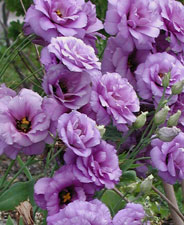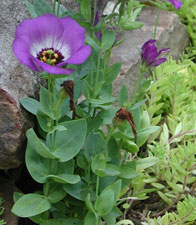Resource Library
Plant of the Week: Lisianthus
The University of Arkansas System Division of Agriculture does not promote, support or recommend plants featured in "Plant of the Week." Please consult your local Extension office for plants suitable for your region.
Plant of the Week
[A-Z]
Lisianthus
Latin: Eustoma grandiflorum

There are lots of beautiful plants in nature, but only a fraction ever make their way to our gardens.
Some are too homely to be of interest; some too demanding to survive the "one size fits all" approach used by greenhouse growers and gardeners. One of our native American wildflowers, Eustoma grandiflorum from the prairie states, is beginning to show potential as a new crop as producers learn to satisfy its demanding requirements.
Eustoma grandiflorum goes by the common name of Texas bluebell, or more commonly, Lisianthus - an old, misapplied botanical name once used for this plant. It belongs to the gentian family which contains a number of beautiful but difficult to grow wildflowers.
It’s native along the 100th meridian in the shortgrass prairies from western Nebraska south to Texas. I’ve met with it only twice in the wild. Once was in the sandy soils of the Great Salt Plains park in western Oklahoma; the other time was on a sandy stretch of beach in Mexico.

In the wild, Lisianthus seems to primarily grow as a biennial, but like most biennials, it can behave as an annual or short -lived perennial provided conditions are just right.
It has broad, glaucous gray-green leaves that extend up the tall, erect stem. The original Lisianthus cultivars were developed for the cut flower market so plants
typically grew 24 inches tall. Newer dwarf forms developed for pot plant production only grow half as tall.
The basic flower color for Lisianthus is purple, but breeders have created a range of colors from pink to white and yellow. They’ve also added a picotee edge to the petals of some cultivars and created double flowered forms.
I first encountered Lisianthus in the spring of 1982 when Sakata Seed Company in Japan sent out trial packets of the new flower they were developing. Over the next few years, I grew successive crops of Lisianthus as a cut flower, pot crop and even as a perennial in the flowering border.
The first thing I learned about growing Lisianthus is that it’s tricky to grow. Early cultivars were too tall to make good pot crops and they succumbed to all known diseases and a few not yet known. Cut flowers were difficult to grow, but they were beautiful and lasted in a vase with no special treatment for two weeks.
Lisianthus is hard to keep alive as a perennial because it needs excellent drainage and dry wintertime conditions. It also requires a soil pH between 6.5 and 7.0. More acidic soil conditions result in zinc toxicity,which slows growth to a crawl. Breeders have made Lisianthus easier to grow, but it’s still one of the most challenging crops for even experienced growers to produce.
Lisianthus seeds germinate quickly but, depending on the average temperature during early seedling growth, they will either flower the first year or form a resting rosette and behave as a biennial. Temperatures around 75 degrees during the seedling stage allows it to flower as an annual; but 85 degrees causes the rosette to form.
The plants I bloomed in early summer in my rock garden were from seed started in late spring last year when the temperature was creeping up, so they behaved as a biennial in my dry planting bed. Plants can be cut back after the flowers fade and a second crop of blooms will appear in six weeks.
By: Gerald Klingaman, retired
Extension Horticulturist - Ornamentals
Extension News - August 11, 2006
The University of Arkansas System Division of Agriculture does not maintain lists of retail outlets where these plants can be purchased. Please check your local nursery or other retail outlets to ask about the availability of these plants for your growing area.